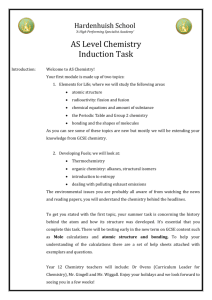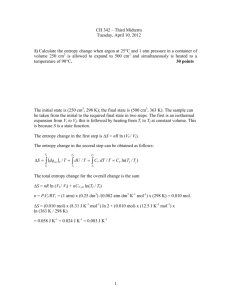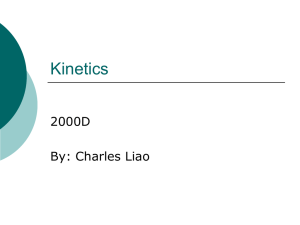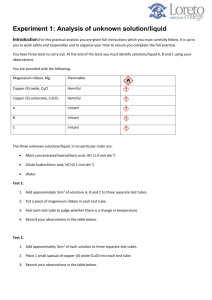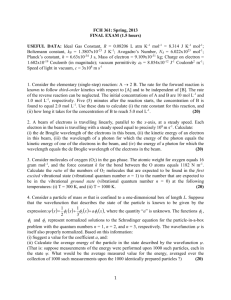2012CEM214SemesterTest2
advertisement
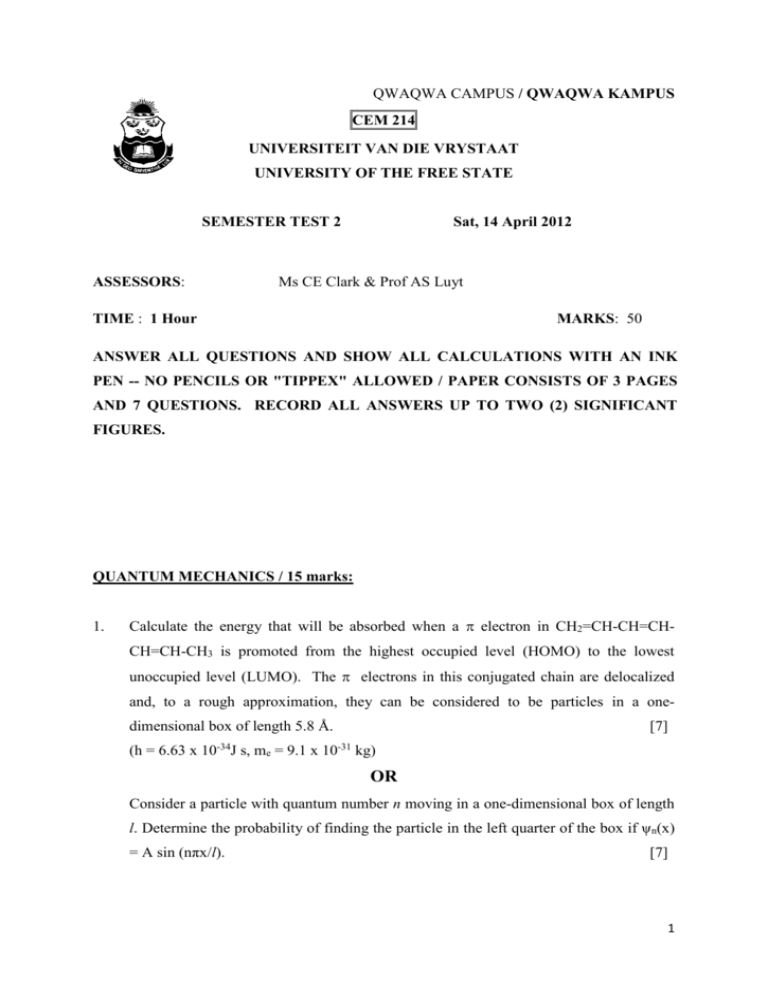
QWAQWA CAMPUS / QWAQWA KAMPUS CEM 214 UNIVERSITEIT VAN DIE VRYSTAAT UNIVERSITY OF THE FREE STATE SEMESTER TEST 2 ASSESSORS: Sat, 14 April 2012 Ms CE Clark & Prof AS Luyt TIME : 1 Hour MARKS: 50 ANSWER ALL QUESTIONS AND SHOW ALL CALCULATIONS WITH AN INK PEN -- NO PENCILS OR "TIPPEX" ALLOWED / PAPER CONSISTS OF 3 PAGES AND 7 QUESTIONS. RECORD ALL ANSWERS UP TO TWO (2) SIGNIFICANT FIGURES. QUANTUM MECHANICS / 15 marks: 1. Calculate the energy that will be absorbed when a electron in CH2=CH-CH=CHCH=CH-CH3 is promoted from the highest occupied level (HOMO) to the lowest unoccupied level (LUMO). The electrons in this conjugated chain are delocalized and, to a rough approximation, they can be considered to be particles in a onedimensional box of length 5.8 Å. [7] (h = 6.63 x 10-34J s, me = 9.1 x 10-31 kg) OR Consider a particle with quantum number n moving in a one-dimensional box of length l. Determine the probability of finding the particle in the left quarter of the box if ψn(x) = A sin (nπx/l). [7] 1 2. The energy of a particle in a cubic box with side length aaa is given by: E nx ,ny 2 2 2 h 2 n x n y n z 8m a2 Draw an energy level diagram for nx, ny and nz = 1 or 2. Show the energy values in h2 terms of . 8ma 2 [8] THERMODYNAMICS / 20 MARKS 3. Gastric juice in humans has an acid concentration of about 1.00 x 10-1 M (pH 1) and it is formed from other body fluids, such as blood, which have an acid concentration of about 4.00 x 10-8 M (pH 7.4). On the average, about 3.00 dm3 of gastric juice are produced per day. Calculate the minimum work required to produce this quantity at 37 C, assuming the behaviour to be ideal. [5] 4. Calculate the entropy change when 1 mol of ice is heated from 250 K to 300 K. Take the heat capacities (CP,m) of water and ice to be constant at 75.3 and 37.7 J.K-1.mol-1, respectively, and the latent heat of fusion of ice as 6.02 kJ.mol-1. [8] 5. Consider the closed system below containing 0.4 mol He at 25 °C. Assume that He acts like an ideal gas. a) Calculate the work done if the plunger/piston moves reversibly and isothermically from x to y. [3] b) Calculate P (in Pa) during the process in (a). [4] 2 ELECTROLYTIC SOLUTIONS / 15 MARKS 6. The equivalent conductivity of a weak electrolyte was determined experimentally at different concentrations and the values are given in the table below: 105C / mol dm-3 104 / S m2 equiv-1 18.180 111.111 41.796 77.519 89.853 54.645 From these results, a graph of C vs. 1/ was obtained and the following values were determined: Slope = 3.1 x 10-8 and y-intercept = -7 x 10-7. Determine: a) ° b) Ka c) (at 1.818 x 10-4 mol.dm-3) 7. [8] Calculate the average ionic activity coefficient, f, of a 0.002 mol dm-3 solution of Zr2(Cr2O7)5. Note: Assume that zirconium has a valency of +5 in this compound. [7] 3 MEMORANDUM: 1. Energy absorbed: CH2=CH-CH=CH-CH=CH-CH3 length of box = 5.8 Å given 6 π-electrons occupy 3 molecular orbitals (MOs) Thus HOMO is E3 Thus LUMO is E4 En h 2n 2 8ma2 h2n2 E E 4 E3 8ma 2 2. h2n2 2 n 4 8ma 6.63x10 Js 4 3 89.1x10 kg 5.8 x10 m 34 31 2 2 2 10 2 n 3 1.25 x10 18 J The possible energies are E111, E121, E211, E112, E122, E221, E212, E222 E111 h 2 1 1 1 h 2 3 8m a 2 8ma 2 h2 E 211 6 2 8ma h2 E112 6 2 8ma E121 h2 h 2 1 2 2 1 6 2 8m a 2 8ma E122 h2 h2 h2 1 2 2 2 2 h2 9 E 9 E 9 2 8ma 2 212 8ma 2 221 8m a2 8ma E 222 h2 h2 22 22 22 12 2 8m a2 8ma 4 18 12h2/8ma2 16 14 Energy levels 12 10 9h2/8ma2 8 6h2/8ma2 6 4 3 h2/8ma2 2 0 3. C1 = C(blood) = 4.00 x 10-8 M C2 = C(gastric juice) = 1.00 x 10-1 M V = 3.00 dm3 T = 37 °C = 310.15 K n(gastric juice) = C(gastric juice) x V(gastric juice) = (1.00 x 10-1 mol.dm-3) x ( 3.00 dm3) = 0.300 mol wrev = nRT ln(C2/C1) = nRT ln[C(gastric juice)/C(blood)] wrev = (0.300 mol)(8.3145 J.K-1.mol-1)(310.15 K) ln[(1.00 x 10-1 mol.dm-3)/( 4.00 x 10-8 mol.dm-3)] = 11396.86 J = 11.40 kJ 5 4. The entropy change when 1 mole of ice is heated from 250 K to 273.15 K: S1 = CP.m ln(273.15 K/250 K) = (37.7 J.K-1.mol-1) x (0.0886) = 3.34 J.K-1.mol-1 For the melting at 273.15 K S2 = dq/T = (6020 J.mol-1)/(273.15 K) = 22.04 J.K-1.mol-1 For the heating from 273.15 K to 300 K S1 = CP.m ln(300 K/273.15 K) = (75.3 J.K-1.mol-1) x (0.0938) = 7.06 J.K-1.mol-1 The entropy change is S = (3.34 + 22.04 + 7.06) J.K-1.mol-1 = 32.44 J.K-1.mol-1 5. n = 0.4 mol Area (A) = 0.5 m2 x = 60 cm = 0.60 m y = 20 cm = 0.20 m V1 = area x distance = 0.5 m2 x 0.6 m = 0.3 m3 V2 = area x distance = 0.5 m2 x 0.2 m = 0.1 m3 T = 298 K Pext = 1 atm = 101325 Pa a) w = -nRT ln(V2/V1) = -[(0.4 mol)(8.3145 J.K-1.mol-1)(298 K) x ln(0.3/0.1)] = -1088.821 J 6 b) P = nRT[1/V2 – 1/V1] = (0.4 mol)(8.3145 J.K-1.mol-1)(298 K)[(1/0.3m3) – (1/0.1m3)] = -6607.256 Pa 6. ° = a) m 3.1x10 8 S m 2 equiv -1 c (7 x10 7 ) = 442.857 x 10-4 S.m2.equiv-1 Ka = slope/(o)2 b) = [3.1 x 10-8/ (442.857 x 10-4)2] mol.dm-3 = 1.58 10-5 mol.dm-3 = ° (at 1.818 x 10-4 mol.dm-3) c) 111.111x10 4 = 442.857 x10 4 = 0.251 7. Zr2(Cr2O7)5 2Zr5+ + 5Cr2O72- 1 Zr 5 z Zr 5 2 1 2 2C 5 2 2 Cr2 O72 z Cr O2 5C 2 2 2 7 2 = ½ [50C – 20C] = 35C = 35 x 0.002 M = 0.07 M log 10 f 0.509 z z 0.509 5 x(2) 0.07 1.3467 f 101.3467 2.222 7


